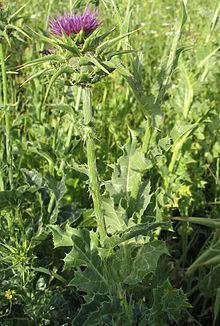Scientific name Silybum Rank Genus | Tribe Cynareae Higher classification Daisy family | |
 | ||
Similar Milk thistle, Carduus, Daisy family, Onopordum, Cirsium | ||
Milk thistle silybum marianum cultivation india seeds available
Silybum (milk thistle) is a genus of two species of thistles in the (daisy family). The plants are native to the Mediterranean regions of Europe, North Africa, and the Middle East. One species has been introduced elsewhere, including in North America. The name "milk thistle" derives from a feature of the leaves, which are prominently banded with splashes of white. Historically, these milky bands were said to be Mother Mary's milk, and this is the origin of another common name, St. Mary's thistle. The most widespread species is Silybum marianum.
Contents
- Milk thistle silybum marianum cultivation india seeds available
- Plant bug or mirid bug plagiognathus arbustorum on thistle flower silybum marianum
- Description and classification
- Health benefits
- References
Many years of research show the active flavanoid-lignan (flavanolignan) group of constituents, called silymarin, contained only in the seed shell has liver-protective and regenerative properties, as well as antioxidant effects. The liver-protective effects were known and written about in ancient times, leading to the active chemical, pharmacological, and safety research beginning in Germany in the 1950s. Clinical use for a variety of liver ailments, such as hepatitis, has also prospered throughout many parts of the world.
Plant bug or mirid bug plagiognathus arbustorum on thistle flower silybum marianum
Description and classification
Members of this genus grow as annual or biennial plants. The erect stem is tall, branched and furrowed but not spiny. The large, alternate leaves are waxy-lobed, toothed and thorny, as in other genera of thistle. The lower leaves are cauline (attached to the stem without petiole). The upper leaves have a clasping base. They have large, disc-shaped pink-to-purple, rarely white, solitary flower heads at the end of the stem. The flowers consist of tubular florets. The phyllaries under the flowers occur in many rows, with the outer row with spine-tipped lobes and apical spines. The fruit is a black achene with a white pappus.
The two species hybridise naturally, the hybrid being known as Silybum × gonzaloi Cantó, Sánchez Mata & Rivas Mart. (S. eburneum var. hispanicum x S. marianum)
Silybum marianum is by far the more widely known species. Milk thistle is believed to give some remedy for liver diseases (e.g. viral hepatitis) and the extract, silymarin, is used in medicine. Mild gastrointestinal distress is the most common adverse event reported for milk thistle. The incidence is the same as for placebo. A laxative effect for milk thistle has also been reported infrequently.
Health benefits
For many centuries extracts of milk thistle have been recognized as "liver tonics." Milk thistle has been reported to have protective effects on the liver and to greatly improve its function. It is typically used to treat liver cirrhosis, chronic hepatitis (liver inflammation), toxin-induced liver damage including the prevention of severe liver damage from Amanita phalloides ('death cap' mushroom poisoning), and gallbladder disorders.
Reviews of the literature covering clinical studies of silymarin vary in their conclusions. A review examining studies with a double-blind protocol concluded that milk thistle and its derivatives has no significant effect on mortality or course of disease in individuals with alcoholic and/or hepatitis B or C disease.
